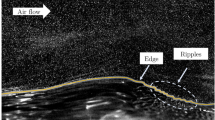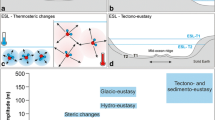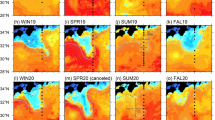Abstract
A common parametrization over snow-covered surfaces that are undergoing saltation is that the aerodynamic roughness length for wind speed (z 0) scales as \({\alpha u_\ast^2/g}\), where u * is the friction velocity, g is the acceleration of gravity, and α is an empirical constant. Data analyses seem to support this scaling: many published plots of z 0 measured over snow demonstrate proportionality to \({u_\ast^2 }\). In fact, I show similar plots here that are based on two large eddy-covariance datasets: one collected over snow-covered Arctic sea ice; another collected over snow-covered Antarctic sea ice. But in these and in most such plots from the literature, the independent variable, u *, was used to compute z 0 in the first place; the plots thus suffer from fictitious correlation that causes z 0 to unavoidably increase with u * without any intervening physics. For these two datasets, when I plot z 0 against u * derived from a bulk flux algorithm—and thus minimize the fictitious correlation—z 0 is independent of u * in the drifting snow region, u * ≥ 0.30 ms−1. I conclude that the relation \({z_0 = \alpha u_\ast^2/g}\) when snow is drifting is a fallacy fostered by analyses that suffer from fictitious correlation.
Similar content being viewed by others
References
Andreas EL (1995) Air-ice drag coefficients in the western Weddell Sea: 2. A model based on form drag and drifting snow. J Geophys Res 100(C3): 4833–4843
Andreas EL (2002) Parameterizing scalar transfer over snow and ice: a review. J Hydrometeorol 3: 417–432
Andreas EL (2009) Relating the drag coefficient and the roughness length over the sea to the wavelength of the peak waves. J Phys Oceanogr 39: 3011–3020
Andreas EL (2011) Relationship between the aerodynamic and physical roughness of winter sea ice. Q J Roy Meteorol Soc 137
Andreas EL, Claffey KJ (1995) Air-ice drag coefficients in the western Weddell Sea: 1. Values deduced from profile measurements. J Geophys Res 100(C3): 4821–4831
Andreas EL, Hicks BB (2002) Comments on “Critical test of the validity of Monin–Obukhov similarity during convective conditions”. J Atmos Sci 59: 2605–2607
Andreas EL, Fairall CW, Guest PS, Persson POG (1999) An overview of the SHEBA atmospheric surface flux program. In: Fifth conference on polar meteorology and oceanography, Dallas, TX, American Meteorological Society, pp 411–416
Andreas EL, Fairall CW, Persson POG, Guest PS (2003) Probability distributions for the inner scale and the refractive index structure parameter and their implications for flux averaging. J Appl Meteorol 42: 1316–1329
Andreas EL, Jordan RE, Makshtas AP (2004) Simulations of snow, ice, and near-surface atmospheric processes on Ice Station Weddell. J Hydrometeorol 5: 611–624
Andreas EL, Jordan RE, Makshtas AP (2005) Parameterizing turbulent exchange over sea ice: the Ice Station Weddell results. Boundary-Layer Meteorol 114: 439–460
Andreas EL, Claffey KJ, Jordan RE, Fairall CW, Guest PS, Persson POG, Grachev AA (2006) Evaluations of the von Kármán constant in the atmospheric surface layer. J Fluid Mech 559: 117–149
Andreas EL, Persson POG, Hare JE (2008) A bulk turbulent air-sea flux algorithm for high-wind, spray conditions. J Phys Oceanogr 38: 1581–1596
Andreas EL, Horst TW, Grachev AA, Persson POG, Fairall CW, Guest PS, Jordan RE (2010a) Parametrizing turbulent exchange over summer sea ice and the marginal ice zone. Q J Roy Meteorol Soc 136: 927–943
Andreas EL, Persson POG, Jordan RE, Horst TW, Guest PS, Grachev AA, Fairall CW (2010b) Parameterizing turbulent exchange over sea ice in winter. J Hydrometeorol 11: 87–104
Banke EG, Smith SD, Anderson RJ (1980) Drag coefficients at AIDJEX from sonic anemometer measurements. In: Pritchard RS (eds) Sea ice processes and models. University of Washington Press, Seattle, , pp 430–442
Bintanja R, Van den Broeke MR (1995) Momentum and scalar transfer coefficients over aerodynamically smooth Antarctic surfaces. Boundary-Layer Meteorol 74: 89–111
Bonekamp H, Komen GJ, Sterl A, Janssen PAEM, Taylor PK, Yelland MJ (2002) Statistical comparisons of observed and ECMWF modeled open ocean surface drag. J Phys Oceanogr 32: 1010–1027
Brunke MA, Zhou M, Zeng X, Andreas EL (2006) An intercomparison of bulk aerodynamic algorithms used over sea ice with data from the Surface Heat Budget for the Arctic Ocean (SHEBA) experiment. J Geophys Res 111: C09001. doi:10.1029/2005JC002907
Chamberlain AC (1983) Roughness length of sea, sand, and snow. Boundary-Layer Meteorol 25: 405–409
Charnock H (1955) Wind stress on a water surface. Q J Roy Meteorol Soc 81: 639
Clifton A, Rüedi J-D, Lehning M (2006) Snow saltation threshold measurements in a drifting-snow wind tunnel. J Glaciol 52: 585–596
De Bruin HAR, Meijninger WML, Smedman A-S, Magnusson M (2002) Displaced-beam small aperture scintillometer test. Part I: the WINTEX data-set. Boundary-Layer Meteorol 105: 129–148
Déry SJ, Taylor PA (1996) Some aspects of the interaction of blowing snow with the atmospheric boundary layer. Hydrol Proc 10: 1345–1358
Doorschot JJJ, Lehning M, Vrouwe A (2004) Field measurements of snow-drift threshold and mass fluxes, and related simulations. Boundary-Layer Meteorol 113: 347–368
Fairall CW, Bradley EF, Rogers DP, Edson JB, Young GS (1996) Bulk parameterization of air-sea fluxes for Tropical Ocean-Global Atmosphere Coupled-Ocean Atmosphere Response Experiment. J Geophys Res 101(C2): 3747–3764
Fairall CW, Bradley EF, Hare JE, Grachev AA, Edson JB (2003) Bulk parameterization of air-sea fluxes: updates and verification for the COARE algorithm. J Clim 16: 571–591
Fuehrer PL, Friehe CA (2002) Flux corrections revisited. Boundary-Layer Meteorol 102: 415–457
Garratt JR (1992) The atmospheric boundary layer. Cambridge University Press, Cambridge, UK, 316 pp
Grachev AA, Fairall CW, Persson POG, Andreas EL, Guest PS (2005) Stable boundary-layer scaling regimes: the SHEBA data. Boundary-Layer Meteorol 116: 201–235
Grachev AA, Andreas EL, Fairall CW, Guest PS, Persson POG (2007) SHEBA flux–profile relationships in the stable atmospheric boundary layer. Boundary-Layer Meteorol 124: 315–333
Guest PS, Davidson KL (1991) The aerodynamic roughness of different types of sea ice. J Geophys Res 96(C3): 4709–4721
Horst TW, Oncley SP, Semmer SR (1997) Measurement of water vapor fluxes using capacitance RH sensors and cospectral similarity. In: Twelfth symposium on boundary layers and turbulence, Vancouver, BC, American Meteorological Society, pp 360–361
Joffre SM (1982) Momentum and heat transfers in the surface layer over a frozen sea. Boundary-Layer Meteorol 24: 211–229
Johnson HK, Højstrup J, Vested HJ, Larsen SE (1998) On the dependence of sea surface roughness on wind waves. J Phys Oceanogr 28: 1702–1716
Kind RJ (1976) A critical examination of the requirements for model simulation of wind-induced erosion/deposition phenomena such as drifting snow. Atmos Environ 10: 219–227
King JC, Pomeroy JW, Gray DM, Fierz C (2008) The fluxes involved in the energy balance. In: Armstrong RL, Brun E (eds) Snow and climate: physical processes, surface energy exchange and modeling. Cambridge University Press, Cambridge, UK, pp 73–83
König G (1985) Roughness length of an Antarctic ice sheet. Polarforschung 55: 27–32
Liston GE, Sturm M (1998) A snow-transport model for complex terrain. J Glaciol 44: 498–516
Male DH (1980) The seasonal snow cover. In: Colbeck SC (eds) Dynamics of snow and ice masses. Academic Press, New York, pp 305–395
Mann GW, Anderson PS, Mobbs SD (2000) Profile measurements of blowing snow at Halley. Antarctica. J Geophys Res 105(D19): 24,491–24,508
Militzer JM, Michaelis MC, Semmer SR, Norris KS, Horst TW, Oncley SP, Delany AC, Brock FV (1995) Development of the prototype PAM III/Flux-PAM surface meteorological station. In: Ninth symposium on meteorological observations and instrumentation, Charlotte, NC, American Meteorological Society, pp 490–494
Overland JE (1985) Atmospheric boundary layer structure and drag coefficients over sea ice. J Geophys Res 90(C5): 9029–9049
Owen PR (1964) Saltation of uniform grains in air. J Fluid Mech 20: 225–242
Panofsky HA (1963) Determination of stress from wind and temperature measurements. Q J Roy Meteorol Soc 89: 85–94
Paulson CA (1970) The mathematical representation of wind speed and temperature profiles in the unstable atmospheric surface layer. J Appl Meteorol 9: 857–861
Persson POG, Fairall CW, Andreas EL, Guest PS, Perovich DK (2002) Measurements near the Atmospheric Surface Flux Group tower at SHEBA: near-surface conditions and surface energy budget. J Geophys Res 107: 8045. doi:10.1029/2000JC000705
Pomeroy JW, Gray DM (1990) Saltation of snow. Water Resour Res 26: 1583–1594
Pomeroy JW, Gray DM, Landine PG (1993) The prairie blowing snow model: characteristics, validation, operation. J Hydrol 144: 165–192
Radok U (1968) Deposition and erosion of snow by the wind. Res. Rep. 230, U.S. Army Cold Regions Research and Engineering Laboratory, Hanover, NH, 23 pp
Raupach MR (1991) Saltation layers, vegetation canopies and roughness lengths. Acta Mech (Suppl) 1: 83–96
Schmidt RA (1986) Transport rate of drifting snow and the mean wind speed profile. Boundary-Layer Meteorol 34: 213–241
Smith SD (1988) Coefficients for sea surface wind stress, heat flux, and wind profiles as a function of wind speed and temperature. J Geophys Res 93(C12): 15,467–15,472
Tabler RD (1980) Self-similarity of wind profiles in blowing snow allows outdoor modeling. J Glaciol 26: 421–434
Uttal T, Curry JA, McPhee MG, Perovich DK, Moritz RE, Maslanik JA, Guest PS, Stern HL, Moore JA, Turenne R, Heiberg A, Serreze MC, Wylie DP, Persson OG, Paulson CA, Halle C, Morison JH, Wheeler PA, Makshtas A, Welch H, Shupe MD, Intrieri JM, Stamnes K, Lindsey RW, Pinkel R, Pegau WS, Stanton TP, Grenfeld TC (2002) Surface Heat Budget of the Arctic Ocean. Bull Am Meterol Soc 83: 255–275
Webb EK, Pearman GI, Leuning R (1980) Correction of flux measurements for density effects due to heat and water vapour transfer. Q J Roy Meteorol Soc 106: 85–100
Wieringa J (1993) Representative roughness parameters for homogeneous terrain. Boundary-Layer Meteorol 63: 323–363
Wyngaard JC (2010) Turbulence in the atmosphere. Cambridge University Press, Cambridge, UK, 393 pp
Author information
Authors and Affiliations
Corresponding author
Rights and permissions
About this article
Cite this article
Andreas, E.L. The Fallacy of Drifting Snow. Boundary-Layer Meteorol 141, 333–347 (2011). https://doi.org/10.1007/s10546-011-9647-8
Received:
Accepted:
Published:
Issue Date:
DOI: https://doi.org/10.1007/s10546-011-9647-8




